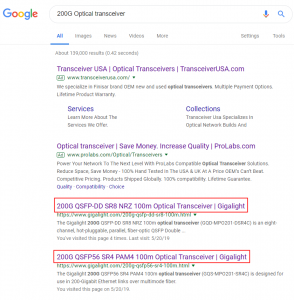
Some network operators choose 200G instead of 400G to address rapid datacenter traffic growth. For example, according to LightCounting reports that Facebook will deploy 200GbE before 400GbE, while Google already has begun 2x200GbE optical transceiver. 200G optical transceiver is expected to find acceptance in parts of the cloud and enterprise data center networking space at the same time frame as 400G.
As we all know, there are just a few suppliers to provide 200G optical transceiver, so it is vital to choose the right supplier for network operators.
Since most companies are unaware of how to choose the right supplier so that they missed the chance to cooperate with the right partner. Here are some ways that will help you verify their effectiveness for your needs.
Google Search Engine
You can affirm the credibility of the optical transceiver supplier by checking the information of 200G optical transceivers. Simply input words such as “200G optical transceiver” or “200G QSFP-DD” onto the Google search engine to see.

Form Factor
There are several 200G form factor such as QSFP-DD, QSFP 56, CFP2. The QSFP-DD form factor addresses the need for high-density, high-speed networking solutions in a module host that’s backwards compatible with QSFP28 and QSFP56.
The QSFP56 is a form factor supporting 200G data rates. This module has the same mechanical design and electrical connector as a QSFP28 but provides a four-lane electrical interface running at 50G PAM4 per channel, instead of 25G NRZ.
The industry standard pluggable CFP2 form factor was designed in accordance with the Implementation Agreement defined by the Optical Internetworking Forum. The CFP2-ACO form factor offers an optics-only solution for customers who currently rely on in-house DSP capabilities. The 200G CFP2-DCO optical transceiver mechanical outline is the standard CFP2 MSA size (106 mm x 41.5 mm x 12.4 mm). Electrical interfaces are provided through the 104-pin connector and optical interfaces through two LC optical receptacle connectors.
Applications
The 200G QSFP-DD optical transceivers are mainly used in hyperscale cloud data centers.
The 200G QSFP56 optical transceivers for applications in hyperscale cloud data centers that require 200G optical connectivity.
The 200G CFP2-ACO optical transceivers are commonly used in the metro carrier and DCI applications where high density and pluggability are more valued.
The 200G CFP2-DCO optical transceivers are a CFP2 MSA-compliant digital coherent optical module designed for line-side trunk DWDM data center interconnect (DCI), metro carrier, and regional/long haul applications.
Services
A good optical transceiver supplier can provide flexible services. Every individual company is different and can provide different services for customers. A high–effective company will be easily contacted by customers and communicate clearly. You can contact us through various channels such as the official website or Facebook, Linkedin and so on.
Conclusion
As an intermediate step between 100G and 400G, 200G optical connectivity is a compelling solution for Cloud Data Centers challenged to implement faster optical links at scalable volumes and costs. DSPs will undoubtedly play a pivotal role on the path to 400G, and in the interim, the fully analog 200G optical transceiver architecture lights the path to faster, cost-effective connectivity beyond 100G.
The 200G optical transceivers from Gigalight were able to meet the demand of customer cost-effectively deploy 200G networks.
